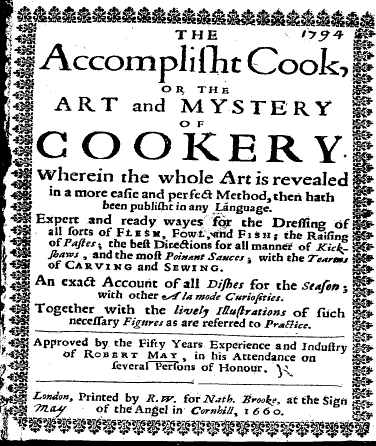You are currently browsing the tag archive for the ‘cookery’ tag.
Robert May was born in Wing in Buckinghamshire around 1588. He worked with his father who served as cook for the Dormer family of Ascott Park and was eventually sent to France to learn the secrets of cookery. He served in the household of Achille de Harlay, first president of the parlement of Paris.
He returned to England and worked as apprentice to Arthur Hollinsworth of Newgate Market in London, cook to the Grocer’s Company and the Star Chamber. In the 1620s he returned to Wing to work for the Dormers. He worked for various employers throughout his career, mostly noble and Catholic.
His book The Accomplisht Cook was published in 1660 and was the first substantial English recipe book to be published after the Restoration. It was so popular it went to five editions by 1685. It combines courtly Elizabethan tradition and more modern French influences. From the Oxford Dictionary of National Biography:
May’s work was a longer and more complete collection of recipes than had appeared before in English, and made use of illustration in a way that had not yet been seen. Cookery was still a closely guarded trade mystery, which May desired to make accessible to all, though admitting that not every reader could afford his most extravagant dishes.
Below are some examples of recipes from The Accomplisht Cook.
Sauce for all manner of Fowls.
Mustard is good with brawn, beef, chine of bacon, and mutton; verjuyce good to boil chickens and capons; swan with chaldrons; ribs of beef with garlick, mustard, pepper, verjuyce, ginger; sauce of lamb, pig and fawn, mustard, and sugar; to pheasant, partridge, and coney, sauce gamelin; to hearn-shaw, egript, plover, and crane, brew and curlew, salt, and sugar, and water of Camot; bustard, shovilland, and bittern, sauce gamelin; woodcock, lapwing, lark, quail, martinet, venison and snite with white salt; sparrows and thrushes with salt and cinamon. Thus with all meats sauce shall have the opperation.
To pickle Cucumbers.
Pickle them with salt, vinegar, whole pepper, dill-seed, some of the stalks cut, charnel, fair water, and some sicamore leaves, and barrel them up close in a barrel.
To Boil a Pike in white Broth.
Cut your pike in three pieces, then boil it in water, salt, and sweet herbs, put in the fish when the liquor boils; then take the yolks of six eggs, beat them with a little sack, sugar, melted butter, and some of the pike broth; then put it on some embers to keep warm, stir it sometimes lest it curdle; then take up your pike, put the head and rail together in a clean dish, cleave the other piece in two, and take out the back bone, put the one piece on one side, and the other piece on the other side, but blanch all, pour the broth on it, and garnish the fish with sippets, strow on fine ginger or sugar, wipe the edge of the dish round, and serve it.
Methods of curing meat have been developing all over the world for many hundreds of years, in order to preserve food for longer. Many delicious products were created through traditions of smoking, drying, salting, pickling. Efforts to preserve meat accelerated with the increase in Atlantic trade, as long naval voyages required food that would keep for a long time.
The industrial revolution and population increases also increased the desire for convenient, long-lasting, cheap food. While beef had been cured with salt for many years, these specific changes led to the emergence and popularity of corned beef as a product.
Ireland already had a tradition of salting beef and so as demand increased from the seventeenth century onwards, Irish companies began providing salt cured beef for trade with the British and the French. This product was used as a provision for naval voyages and also for civilian consumption in Britain and in the colonies.
The method of curing the beef was to mix large chunks of salt called ‘corns’ with the chopped beef in a large pot or jar. The word ‘corn’ derives from the old Germanic word ‘kurnam’, meaning seed, grain or kernel.
During the industrial revolution, corned beef began to be mass produced in cans, reaching its height during the Second World War. During this time, most of the corned beef consumed was imported from Fray Bentos in Uruguay.
Today corned beef and cabbage is considered a traditional Irish dish, enjoyed in the USA on St. Patrick’s Day. However in reality, this is an American tradition started by Irish immigrants to America in the nineteenth century.
In Ireland corned beef has never been that popular; although it was manufactured in Ireland, the cattle and means of production were owned by the British colonizers and most of the product was exported. Pork was much more popular for ordinary Irish people.





Recent Comments